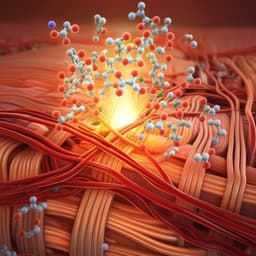
Medicine and Health
Novel Heme Oxygenase-1 Inducers Palliate Inflammatory Pain and Emotional Disorders by Regulating NLRP3 Inflammasome and Activating the Antioxidant Pathway
M. Pérez-fernández, I. Suárez-rojas, et al.
Explore groundbreaking research by Montse Pérez-Fernández and colleagues, who uncover the potential of novel heme oxygenase-1 inducers to combat chronic inflammatory pain, anxiety, and depression, offering hope for more effective and safer treatments.
~3 min • Beginner • English
Introduction
Chronic pain is a prevalent, complex condition with substantial social and public health burden. It features hyperalgesia, allodynia, and impaired physical functioning, and is frequently comorbid with anxiety and depression, which can worsen pain perception. Existing treatments (opioids, NSAIDs) are limited by suboptimal efficacy and adverse effects. Oxidative stress during inflammation can increase mitochondrial ROS, activating the NLRP3 inflammasome and promoting pro-inflammatory cytokines (IL-1β, IL-18), contributing to inflammatory pain and depressive-like behaviors; thus, NLRP3 inhibition is a potential strategy. Nrf2 is a key transcription factor controlling antioxidant and cytoprotective genes (e.g., HO-1, NQO1, GSTM1, SOD-1); its activation alleviates inflammatory and neuropathic pain, primarily by enabling nuclear translocation under oxidative stress to induce antioxidant gene expression. DMF, an FDA-approved Nrf2 activator for multiple sclerosis, has anti-inflammatory, antioxidant, and neuroprotective properties and shows analgesic efficacy in osteoarthritis, neuropathic, and post-operative pain, improves grip strength after nerve injury or MS, and can suppress NLRP3 activation. Novel DMF-derived compounds (1m, 1a, 1b) were synthesized to enhance HO-1 induction and reduce ROS in vitro, with 1m the most potent HO-1 activator; however, their in vivo antinociceptive and emotion-related effects in inflammatory pain were unknown. The study’s objective was to test whether DMF, 1m, 1a, and 1b reduce CFA-induced mechanical allodynia, thermal hyperalgesia, grip strength deficits, and anxiety- and depressive-like behaviors, and to determine their effects on NLRP3, Nrf2, HO-1, SOD-1, NQO1, and GSTM1 in paw tissue and amygdala.
Literature Review
Prior work implicates oxidative stress and NLRP3 inflammasome activation in inflammatory pain and mood disturbances, and identifies Nrf2 activation as analgesic in inflammatory and neuropathic pain models. DMF activates Nrf2 via Keap1 modification and has demonstrated anti-inflammatory, antioxidant, neuroprotective, and analgesic effects across models (osteoarthritis, neuropathic, post-operative pain), improves grip strength post-nerve injury, and attenuates gouty arthritis and colitis by suppressing NLRP3. HO-1, a key Nrf2 target, is cytoprotective and anti-inflammatory with antinociceptive effects, whereas HO-2 may be pronociceptive. Newly synthesized DMF derivatives (1m, 1a, 1b) enhance HO-1 expression more than DMF in vitro and reduce ROS without cytotoxicity. Sulforaphane, another Nrf2 activator, also shows antinociceptive and mood benefits and upregulates antioxidant enzymes. Collectively, literature supports targeting NLRP3 inhibition and Nrf2/HO-1 activation to treat inflammatory pain and associated emotional disorders, motivating in vivo evaluation of 1m, 1a, 1b versus DMF.
Methodology
Animals: Male C57BL/6 mice (Envigo, Barcelona) housed under 12/12 h light/dark, 22 ± 1 °C, 55 ± 10% humidity, food/water ad libitum; acclimated 7 days. Procedures followed EU Directive and Spanish Law (RD 53/2013), approved by UAB ethics committee (code 9863).
Inflammatory pain model: CFA (30 μL) injected subplantarly into the right hind paw under brief isoflurane anesthesia (3% induction/maintenance).
Behavioral assessments:
- Mechanical allodynia: von Frey filaments (0.4–3.0 g), up-down method; positive response defined as withdrawal/licking/shaking.
- Thermal hyperalgesia: Hargreaves plantar test; three trials measured, 12 s cutoff to avoid damage.
- Grip strength: computerized grip strength meter (Ugo Basile Model 47200); 3–4 measurements/animal.
Emotional-like behaviors:
- Anxiety-like: Elevated Plus Maze (EPM; 5 min, entries and time in open vs closed arms) and Open Field (OF; 5 min, entries/time in center, locomotion).
- Depressive-like: Tail Suspension Test (TST; 8 min, immobility in last 6 min) and Forced Swim Test (FST; 6 min, immobility in last 4 min; 24 ± 1 °C water).
Blinding: Experimenters were blinded; animals habituated 1 h before tests.
Drug treatments: DMF (Sigma) and compounds 1m, 1a, 1b (synthesized per refs) dissolved in 0.05% Cremophor EL/dimethyl sulfoxide/ethanol (12:2:2). Dose: 300 mg/kg p.o., once daily for 4 consecutive days. Vehicle (VEH) matched.
Experimental design:
- Analgesia/functional cohort: DMF, 1m, 1a, 1b, or VEH given days 13–16 after SS or CFA. Assessments at day 0 (baseline), day 12 (pre-treatment), and days 13–16, 3 h post-dose. Groups: SS-VEH, SS-DMF, SS-1m, SS-1a, SS-1b (n=6 each) and CFA-VEH, CFA-DMF, CFA-1m, CFA-1a, CFA-1b (n=6 each); total 60 mice.
- Affective cohort: Same dosing (days 13–16); EPM/OF and TST/FST on day 16, 3 h post-dose. Groups: SS-VEH, CFA-VEH, CFA-DMF, CFA-1m, CFA-1a, CFA-1b; n=8/group; total 48 mice. Overall n=108.
Protein analyses: Western blot on ipsilateral paw tissue and contralateral amygdala harvested 16 days post-injection. Targets: NLRP3, Nrf2, HO-1, SOD-1, NQO1, GSTM1; GAPDH loading control. Standard RIPA lysis, sonication, SDS-PAGE, PVDF transfer, specific primary/HRP-secondary antibodies, chemiluminescence, densitometry with ImageJ. n=3 samples/group.
Statistics: Normality by Kolmogorov–Smirnov. Three-way repeated-measures ANOVA (inflammation × treatment × time) for analgesia/functional data; one-way ANOVA with Tukey post hoc for between-group comparisons (behavioral and protein data). Significance p<0.05; data as mean ± SEM.
Key Findings
- Mechanical allodynia: Significant main effects of inflammation (p<0.003), time (p<0.000), treatment (p<0.05) and significant interactions, including triple interaction (p<0.000). CFA reduced withdrawal threshold vs SS-VEH (p<0.001). 1m completely reversed allodynia after 2 days, outperforming DMF, 1a, 1b at that time (p<0.001). DMF, 1a, and 1b required 3 days to block allodynia.
- Thermal hyperalgesia: Significant effects of inflammation, treatment, and time (all p<0.000) and interactions including triple (p<0.000). Two days of 1m or 1b fully reversed hyperalgesia (vs SS-VEH p<0.001); DMF and 1a required 3 days. At day 2, 1m and 1b produced greater antihyperalgesia than DMF and/or 1a.
- Grip strength: Significant effects of inflammation (p<0.027), treatment (p<0.001), time (p<0.000), with significant interactions including triple (p<0.000). After day 12 deficit, VEH and DMF showed similar recovery over 3 days, but DMF surpassed VEH at day 16 (p<0.001). 1m, 1a, and 1b completely reversed deficits after 2 days (vs SS-VEH p<0.001).
- Anxiety-like behavior: EPM open-arm entries decreased by CFA+VEH vs SS-VEH (p<0.003); normalized by DMF, 1m, 1a, 1b. No group differences in time in open arms or closed-arm entries. OF center time decreased in CFA+VEH (p<0.000); normalized by all treatments. No differences in center entries or locomotion (squares crossed).
- Depressive-like behavior: TST and FST immobility increased by CFA (p<0.005 vs SS-VEH); reduced to control levels after 4-day treatment with DMF, 1m, 1a, or 1b.
- Paw protein expression: CFA upregulated NLRP3 (p<0.002 vs SS-VEH); normalized by DMF, 1m, 1a, 1b. Nrf2 expression increased with all treatments vs VEH groups (p<0.000). HO-1 was upregulated by CFA+VEH (p<0.000) and remained high with DMF, 1m, 1a; 1b further amplified HO-1 vs VEH or DMF (p<0.000). SOD-1 increased in CFA groups (VEH and treated) vs SS-VEH (p<0.001). NQO1 and GSTM1 showed no significant changes.
- Amygdala protein expression: CFA upregulated NLRP3 (p<0.000 vs SS-VEH); normalized by DMF, 1m, 1a, 1b. All treatments significantly increased HO-1 vs SS-VEH or CFA-VEH (p<0.000). Nrf2, SOD-1, NQO1, GSTM1 showed no significant differences between groups.
Overall efficacy ranking: 1m was most effective for rapid reversal of allodynia, hyperalgesia, and grip strength deficits; 1b matched 1m for hyperalgesia and, with 1a, rapidly restored grip strength; DMF required longer to achieve comparable effects.
Discussion
The study demonstrates that short-course oral treatment with novel HO-1 inducers (1m, 1a, 1b) and DMF alleviates CFA-induced inflammatory pain, restores motor function (grip strength), and reverses anxiety- and depressive-like behaviors. Mechanistically, these benefits align with suppression of the NLRP3 inflammasome and activation of the antioxidant pathway, notably increased Nrf2 and HO-1 (and SOD-1 in paw), with central (amygdala) increases in HO-1. The normalization of peripheral and amygdalar NLRP3 suggests anti-inflammatory actions underpin both antinociceptive and mood-improving effects. Enhanced HO-1, particularly with 1b in paw and across all treatments in amygdala, supports HO-1’s central and peripheral roles in modulating nociception and affective states. The lack of changes in amygdalar Nrf2 and SOD-1 may reflect higher basal levels sufficient to buffer oxidative stress centrally. Compared to DMF, the new inducers—especially 1m—achieved faster and more complete symptom reversal, consistent with their higher HO-1–inducing potency reported in vitro. These findings extend prior evidence on Nrf2/HO-1 activation and NLRP3 inhibition as therapeutic strategies for inflammatory pain and its emotional comorbidities, positioning 1m, 1a, and 1b as promising candidates.
Conclusion
Oral administration of DMF and the novel HO-1 inducers 1m, 1a, and 1b produced robust analgesia, restored grip strength, and reversed anxiety- and depressive-like behaviors in a mouse model of CFA-induced inflammatory pain, with 1m showing the most rapid and comprehensive efficacy. The effects are associated with suppression of NLRP3 inflammasome activation and activation of antioxidant defenses via Nrf2/HO-1 (and SOD-1 peripherally), and increased HO-1 in the amygdala. These compounds, particularly 1m, emerge as promising treatments for inflammatory pain and related emotional syndromes. Future research should investigate efficacy across sexes, dosing optimization, long-term safety, and translational potential.
Limitations
The study was conducted only in male mice, limiting generalizability across sexes. Additional limitations include a single dose and treatment duration, and protein analyses with small sample sizes (n=3 per group), warranting further studies to assess dose–response, chronic administration, and sex differences.
Related Publications
Explore these studies to deepen your understanding of the subject.







